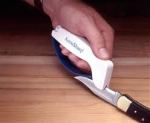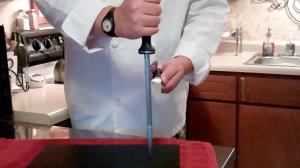The straw polls are over and Iowa’s never-ending campaign season is in full bloom. Aside from their uncanny ability not to be embarrassed by anything they do (or have done), I wondered what other abilities are essential for professional politicians…

I have not had much time for cooking over the past week or so…and less time for writing. Being one hound “short” drove us back to the reality that, when the other old hound catches his bus, we will become official short-timers in Iowa. We have begun sorting out future dumpster ballast from future yard sale chotchke that will be destined to be someone else’s dumpster ballast. With nothing tasty on my mind, readers will have to endure a tip from Phyne Dyning on how to keep those knives sharp.
Iowa. We have begun sorting out future dumpster ballast from future yard sale chotchke that will be destined to be someone else’s dumpster ballast. With nothing tasty on my mind, readers will have to endure a tip from Phyne Dyning on how to keep those knives sharp.
Visitors to the Phyne Dyner’s kitchen are frequently put to work. Provided they are still sober, they are often given a knife and something to chop or slice.
It is not so much that I need their help with chopping and slicing as it is that I enjoy seeing their faces when, for probably the first time ever, they are given a truly sharp knife with which to chop or slice.
The sad fact is, most home kitchens have knives as sharp as Miss America contestants.
“And after I build houses for every homeless person, as Miss America I will try to bring about world peace, cure cancer, and market painless Brazilian waxes.”
Many of my kitchen visitors try to assuage their guilt over keeping dull cutlery by claiming that dull knives are less likely to result in accidental cuts.
While this is not only false, it also makes no sense to keep a “safe”, dull knife that cannot be used to cut the stuff you actually want to cut.
Among country boys, knife sharpness is a coveted man-skill on par with the ability to belch the tune to Dixie while keeping time with passed gas. After years of fumbling with my own knives, I finally asked some good-ole-boys in West Texas about knife sharpening and care.
So, how does the home chef keep kitchen cutlery surgically sharp? (Readers who even considered using a good kitchen knife to tighten an eyeglass screw are now excused.)
Anatomy of a sharp knife
Most knives (American and European) are sharpened at 20-22 degrees of angle from the blade. Knives that are extremely sharp, such as surgical scalpels, are sharpened at 10 degrees of edge angle. (Phun Phyne Dyning Phact to Know and Tell: Many Asian knives are given 18-degree edge angles.) Some high-end manufacturers deliberately sell minimally sharpened blades (“rough-sharpened”), knowing that the professional purchaser will have the blade professionally (“fine”) sharpened and honed before it is put into service. However, it is most common to find newly purchased blades in kitchen supply stores to already be carefully honed and ready for use.
In addition to a honed edge, good cutting blades have “teeth”. Think of these as “mini-serrations” like those found on inexpensive kitchen cutlery.
The teeth are actually striations placed on a sharpened edge. The most common way teeth are “set” on a knife blade is by using a “steel”. A steel is a long, rod-like appliance having striations on its surface running parallel to the long axis of the rod. The steel used in a steel is harder than the steel used in the knife blades they are used upon.
Finally, the sharpened teeth are polished through stropping.
A “strop” is a long piece of harness leather, looking every bit like a 1970s women’s trouser belt, used to remove microscopic burrs left behind during the previous sharpening steps.
The result is a blade with a chisel-shaped edge, covered with teeth, and finely polished.
Sharpening
Sharpening is the step where the knife edge is given its 20-22 degree bevel (“edge angle”). While it may be tempting to strive for a surgical blade edge having a 10 degree edge angle, it is almost impossible to accomplish that kind of accuracy without special equipment.
The bevel can be created by hand or mechanical grinding.
There is a Catch-22 with sharpening.
Either by hand or by machine, a novice can quickly ruin an excellent knife to the point where it must be professionally re-sharpened. However, the only way for a novice to become an expert is by sharpening a lot of knives. In the meantime, the novice finds him/herself using mediocre blades until he/she achieves competence in knife sharpening.
Isn’t this fun?
The only way to learn is to dive in. Remember, if you end up with a hopelessly dull blade, despite your best efforts, you can always have a professional fix your mistake.
I am betting that many readers will end up with poor first-time results. It takes a fair amount of practice to accurately sharpen a blade.
So, you have “ruined” the factory edge with your efforts…what now?
Professional sharpening can be had at many hardware stores or kitchen supply shops. I always had reservations about entrusting $1200 worth of knives to the kid at the hardware store, so I resorted to “other means”.
My local butcher (in small-town West Texas) was willing to call me when the itinerant “knife guy” came to town. For the price of a case of cold beer, my butcher tossed my knives in with his for the visiting pro to work his magic upon. Best of all, I was only without my knives for an afternoon or a morning.
There is also Knife Sharpening for Dummies.
 One can find hand-sharpening apparatus with all manner of jigs to hold the blade properly while the dummy holding the knife handle sharpens it. Some use Arkansas stones and others use very hard steel
One can find hand-sharpening apparatus with all manner of jigs to hold the blade properly while the dummy holding the knife handle sharpens it. Some use Arkansas stones and others use very hard steel rods or ceramic-coated (or diamond) rods. These cost $20-100 and, with reasonable care, deliver a pretty nice edge.
rods or ceramic-coated (or diamond) rods. These cost $20-100 and, with reasonable care, deliver a pretty nice edge.
Mechanical sharpeners are Satan’s spawn if they are improperly used.
The worst of these use a dry, stone wheel turning at a high RPM. The wheel may have a bevel of 20 degrees or the sharpener may have a jig to hold the blade as it is guided against the spinning wheel. Prices range from $25 to $150.
A natural consequence of applying a dry, rapidly spinning sharpening wheel against a steel blade is heat generation. Failure to move the blade at a steady rate can result in over-ground areas or extreme heat generation that can remove the temper from a good blade in very short order.
 Many fine knives have been ruined by amateurs using dry wheel mechanical sharpeners.
Many fine knives have been ruined by amateurs using dry wheel mechanical sharpeners.
Most professional knife sharpeners use a mechanical, wet spinning stone.
These sharpeners have a continuous flow of water (or slurry) over the blade where it touches the spinning stone. The water or slurry cools the blade, making heat generation less likely, but not impossible. The higher end versions of these sharpeners move the blade at a constant speed across the sharpening surface. A simple sharpener with a water bath can cost $250 to $500. A sharpener with a water bath and the ability to move a blade mechanically across the stone at a constant speed can cost $1000 to $10,000. Machines capable of sharpening multiple blades simultaneously can be purchased for about the price of a luxury sedan.
Visit with a professional knife sharpener at his shop. It is easy to see why a possible $10 to $25 per knife charge is money well earned. A good shop can also repair and replace handles on damaged knives, re-haft, and straighten bent blades.
blades.
Hone Sweet Hone
Some folks use “sharpen” and “hone” interchangeably. “Honing”, for our discussion, will refer to the intermediate step in the process where “teeth” are added to the edge angle through the use of a “steel”.
Most home chefs are familiar with the steel and associate its use with flamboyance and daring-do while the chef waves a clattering knife over its surface.
While it is possible for an experienced chef to accurately hone a knife in this manner, it is nearly impossible for an amateur to maintain the correct edge angle while waving the knife and steel through the air. Remember, the knife edge is best when precisely sharpened at 20-22 degrees…not 13 to 45 degrees…varying over the entire edge length!
I have been sharpening my own knives for about ten years and I am first to admit that I cannot accurately hold the proper angle unless one of the implements is anchored to terra firma.
Here is my process:
 Grab a cutting board. Grasp the steel by its handle and poke the end of the rod into the cutting board perpendicular to the cutting board surface.
Grab a cutting board. Grasp the steel by its handle and poke the end of the rod into the cutting board perpendicular to the cutting board surface.
Now, gently hold the knife blade against the steel at a 90-degree angle (perpendicular to the steel). Roll the back edge of the knife upwards, creating a 45-degree angle. Now, roll the back edge of the knife one-half of the way up, creating a 22.5-degree angle. Finally, with practice, you will be able to very slightly roll the back edge upward to create a perfect 20 to 22 degree angle between the blade and the steel.
Here is where the process gets critical.
The proper way to move the blade against the steel is to move as though you are attempting to shave off a thin slice of the steel using the knife blade. Your wrist must remain rigid and keep the knife edge parallel to the cutting board while maintaining the 20 to 22 degree edge angle. Consequently, your arm moves straight down as your elbow moves  toward the wall behind you. At the same time, keep gentle pressure on the blade to keep it in contact with the steel during the entire movement.
toward the wall behind you. At the same time, keep gentle pressure on the blade to keep it in contact with the steel during the entire movement.
Properly done, it is much like patting your head while rubbing your stomach.
When you reach the bottom of the steel, move the blade away from the steel and return it to the starting position. Before making another stroke, be sure to re-establish the proper blade edge angle.
Complete 3 to 10 strokes and then move the blade to the opposite side of the steel. Complete 3 sets of 3-10 strokes per side and then test the blade for sharpness. If at the end of three sets per side, the blade is not sharp, you may need to return to the sharpening steps.
Take heart! It is almost (!) impossible to ruin a good knife edge with a steel. The steel does not remove metal from the edge. It merely “scratches” teeth into the edge. I did say  almost impossible. I doubt any of Phyne Dyning’s readers are so ham-handed that they can (or will) achieve the impossible.
almost impossible. I doubt any of Phyne Dyning’s readers are so ham-handed that they can (or will) achieve the impossible.
Strop the world, I want to get off
“To strop, or not to strop…”
In my not so humble opinion, stropping is optional for most home chefs. However, for the “belt AND suspender” readers, I will cover stropping.
Fasten one end of the stropping leather to a solid bench, wall, or heavy sous chef. Pull the leather strop taut…and strop.
The stropping motion involves holding the blade approximate to the edge angle and pulling the back edge of the knife away (or towards) you. The blade, in stropping, is moved  opposite to the cutting (or sharpening) direction. A dozen strokes is sufficient to remove burrs and loose metal shavings from the sharpening and honing process.
opposite to the cutting (or sharpening) direction. A dozen strokes is sufficient to remove burrs and loose metal shavings from the sharpening and honing process.
But, is it sharp?
Carefully examine the knife edge under bright light. Nicks and gouges will show up as “flares” of light along the edge. Examine the edge from the side. You should see a fine “line” of the sharpened edge. The line should be of uniform thickness and will appear lighter than the surrounding blade material.
I never test a knife by using my own skin. I never “test-cut” a piece of paper with a blade.
Test a blade by cutting something you will be using the knife to cut. A ripe tomato, a ripe grape, or a thin “sheet” of onion works well.
Test the knife by slowly cutting the item using the full length of the blade. The movement should be effortless and requiring virtually no downward pressure to make the cut. If the knife jerks or bites as the cut is made, this suggests there are minute nicks in the edge which need removal through re-honing or further stropping. If the nick is very deep, the sharpening process will need to be repeated.
“Wow! They’re sharp. Now what?”
Do not simply toss your newly sharpened knives into a kitchen drawer. The reason against this should be obvious. If your home kitchen is frequented by crumb-crunchers (kids) a secure drawer may be the safest place for your knives. I do not recommend storing knives on overhead shelves because you cannot see the edge as you grab around to find the knife you want.
Knives should be stored in a knife block, a magnetic knife rack, or in a padded case (best). Field-expedient cases may be manufactured out of folded cardboard fashioned into a scabbard. The open side is carefully taped (not stapled) together and the knife is slid into the scabbard for storage.
Keep your knives clean.
Most home chefs prefer stainless steel knives for their rustproof characteristic. While stainless knives do not “rust”, the steel can be pitted by some substances if they are left in contact with the blade. Consequently, all of my knives are washed immediately after they are used.
I never wash my knives in the dishwasher and safe practice dictates that a knife never be tossed into a sink or dish pan full of soapy water. You want to be able to see the edge of any knife before you grab it.
Pros who use carbon steel blades seldom apply rust preventatives to the blades unless the knife is to be stored for a long (more than a week) time. A kitchen rag dipped in vegetable oil is a fair choice. However, vegetable oils can become gummy over time and can attract and retain dust and other crud. Organic oils can become rancid and give cut foods an “icky” taste.
I use a rust preventative intended for coating firearms bores during storage. Most of this gunk is not approved for use around food, so my long-term storage knives always get a careful scrubbing before use.
I have a few carbon steel knives that are nearly forty years old. The blades have developed a rich patina, but remain sharp and useable. Most of my high-end blades are stainless steel. I store them carefully on a magnetic rack and transport them in cardboard scabbards inside of a (locked) briefcase. Few of my knives have been through the entire sharpening/honing/stropping process more than a half-dozen times during their lives.
Your kitchen knives probably represent a significant portion of your kitchen equipment budget. With care and proper handling, your knives are likely to become treasured heirlooms to be passed between generations.





















